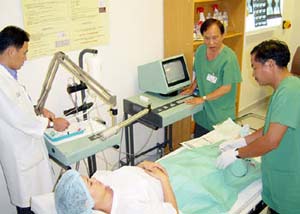Many individuals experience symptoms of urinary leakage naturally and uncontrollably. However, due to embarrassment and the belief that this does not affect their health, they accept living with “the wetness” without seeking treatment.
 |
| Urodynamic examination for a woman with urinary incontinence. (Photo: M.L) |
Dr. Nguyen Van Nhan, a urodynamics specialist at FV Hospital in Ho Chi Minh City, states that the uncontrolled leakage of urine is referred to as “urinary incontinence.” This condition often occurs when there is an increase in abdominal pressure, such as during laughter, sneezing, coughing, lifting heavy objects, or engaging in sports (tennis, running, volleyball, basketball, etc.). While urinary incontinence does not affect overall health and does not lead to long-term complications, it can cause infections in the genital tract due to constant moisture.
According to Dr. Nhan, approximately 10-20% of women in the community experience symptoms of “urinary incontinence.” Women who have recently given birth or those aged 55 and older are most susceptible. The pelvic floor in women has a unique structure, making it more vulnerable during pregnancy or hormonal changes during menopause. These factors can weaken and soften the tissues in the urinary and reproductive organs, resulting in urinary incontinence. Additionally, young women who experience stress, engage in heavy sports, or do not rest adequately after childbirth may also encounter this symptom.
There are two common types of urinary incontinence:
– The first type is stress incontinence, which occurs when there is a physical exertion. It is common in women due to the weakening of the pelvic floor and the muscles that control urination. Under increased abdominal pressure, urine may involuntarily escape.
– The second type is urge incontinence, which occurs due to an unstable or overactive bladder or urinary obstruction, typically seen in older men. Benign prostatic hyperplasia (enlargement of the prostate) is a common condition that leads to this phenomenon.
Currently, most cases of urinary incontinence can be treated successfully. In some instances, patients only need to perform exercises aimed at strengthening the muscles that control urination, as advised by their doctors. In more severe cases, a thorough examination and testing using specialized diagnostic techniques (known as urodynamics) will be conducted. Treatment can then be prescribed based on the results, which may include medication or surgery.
For stress urinary incontinence, which often affects women due to increased abdominal pressure, simply reducing the factors contributing to exertion, alongside strengthening exercises for the pelvic area, can significantly reduce or eliminate the symptoms. If symptoms persist after following a doctor’s guidance, a specialist may recommend surgical intervention. The most common procedure today is the insertion of a mid-urethral sling (TVT – TOT) at the site of the muscle controlling urination. This minimally invasive surgery can be performed through natural pathways and typically allows for discharge within 24 hours with minimal pain. About 90% of women are completely cured after surgery.
In cases of urge incontinence due to urinary obstruction from prostate enlargement, medical treatment with medication is often effective. For severe cases, surgery may be necessary to remove the obstruction. In instances of an overactive bladder, if medication fails, doctors may inject botulinum toxin A into the bladder via cystoscopy as a treatment option. This procedure is performed under general anesthesia and lasts about 30 minutes, with patients often being discharged the same day.
Since urinary incontinence is a common issue among women, it is advisable to keep a record of the timing and circumstances under which symptoms occur. Consulting a urology specialist for examination and appropriate treatment options is recommended, as urinary incontinence can affect anyone, regardless of gender or age.
“Although it may not significantly impact health, it greatly affects the psychology, self-confidence, and family life of many individuals,” cautioned Dr. Nhan.
My Lan


















































